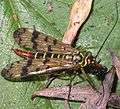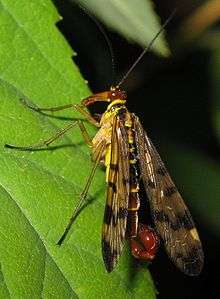Mecoptera
| Mecoptera Temporal range: Permian - Recent 299–0 Ma | |
|---|---|
 | |
| Panorpa communis, male | |
| Scientific classification | |
| Kingdom: | Animalia |
| Phylum: | Arthropoda |
| Class: | Insecta |
| (unranked): | Antliophora |
| Order: | Mecoptera Hyatt & Arms, 1891 |
| Families[1] | |
| |
Mecoptera (from the Greek: meco- = "long", -ptera = "wings") are an order of insects with about 550 species in nine families worldwide. Mecoptera are sometimes called scorpionflies after their largest family, Panorpidae, in which the males have enlarged genitals that look similar to the stinger of a scorpion. The Bittacidae, or hangingflies, are a prominent family of elongate insects known for their elaborate mating rituals, in which females choose mates based on the quality of gift prey offered by various males.
While modern Mecoptera are overwhelmingly predators or consumers of dead organisms, early ones might have played an important role before the evolution of other insects in pollinating extinct gymnosperms.[2][3]
Anatomy and biology
Mecoptera are small to medium insects with slender, elongated bodies. They have relatively simple mouthparts, with long mandibles and fleshy palps, which resemble those of the more primitive true flies. Like many other insects, they possess compound eyes on the sides of their heads, and three ocelli on the top. Most Mecoptera feed on vegetation in moist environments; in hotter climates, they may therefore be active only for short periods of the year.[4]
_anatomy.tiff.jpg)
A, Body in lateral view; B–D. male genital bulb and gonostyli. B, dorsal view; C, ventral view; D, lateral view. ep, epandrium; gcx, gonocoxite; gs, gonostylus; hv, hypovalva; hyp, hypandrium. Scale bars represent 3 mm in A, 1 mm in B–D
The wings are narrow in shape, with numerous cross-veins, and somewhat resemble those of primitive insects such as mayflies. A few genera, however, have reduced wings, or have lost them altogether. The abdomen is cylindrical, and typically curves upwards in the male, superficially resembling the tail of a scorpion, the tip containing an enlarged structure called the genital bulb.
The female lays the eggs in close contact with moisture, and the eggs typically absorb water and increase in size after deposition. In species that live in hot conditions, the eggs may not hatch for several months, the larvae only emerging when the dry season has finished. More typically, however, they hatch after a relatively short period of time.[4]
The larvae are usually quite caterpillar-like, with short, clawed, true legs, and a number of abdominal prolegs. They have sclerotised heads with compound eyes and mandibulate mouthparts. The tenth abdominal segment bears either a suction disc, or, less commonly, a pair of hooks. They generally eat vegetation or scavenge for dead insects, although some predatory larvae are known.[4]
The larva crawls into the soil or decaying wood to pupate, and does not spin a cocoon. The pupae are exarate, meaning the limbs are free of the body, and are able to move their mandibles, but are otherwise entirely nonmotile. In drier environments, they may spend several months in diapause, before emerging as adults once the conditions are more suitable.[4]
Evolution
DNA evidence indicates that the fleas, traditionally a separate order (Siphonaptera), are instead highly specialized scorpionflies.[5] The Boreidae are the sister clade to the Siphonaptera, so "Mecoptera" is paraphyletic, but there is a clade that contains both Mecoptera and Siphonaptera, with about 3000 known species.[6] Two synapomorphies are the production of resilin, a very flexible and springy type of cuticle, and a reversion to panoistic ovarioles.
Mecoptera have special importance in evolution of Insecta. Two of the most important insect orders, Lepidoptera and Diptera, along with Trichoptera, probably evolved from ancestors belonging to, or strictly related to, the Mecoptera. This is apparent from anatomical and biochemical similarities, but, moreover, transitional fossils, such as Permotanyderus and Choristotanyderus, have been discovered to lie between the Mecoptera and Diptera.[4]
The group was once much more widespread and diverse than at present, having as many as four suborders during the Mesozoic.[4]
First pollinators

Extinct Mecoptera species have been proposed to have been important plant pollinators.[2][3] Early nonangiosperm gymnosperm seed plants during the late Middle Jurassic to mid–Early Cretaceous period have been believed to be mainly wind-pollinated. However, examination of fossil mecopterans show they had siphon feeding apparatus that could fertilize early gymnosperms by feeding on their nectar and pollen. The lack of iron enrichment in their fossilized probosces rules out a use in blood drinking. One question over this suggestion is that so far pollen has not been found associated with these feeding parts, which is surprising for the amber-encased insects which should have preserved pollen, but "further fossils may provide this information".[2]
Eleven species have been identified belonged to three families, Mesopsychidae, Aneuretopsychidae, and Pseudopolycentropodidae for which "the encompassing name Aneuretopsychina is available".[3] Their lengths range from 3 mm in Parapolycentropus burmiticus to 28 mm in Lichnomesopsyche gloriae.[3] The proboscis could be as long as 10 mm. Pollen transfer has been suggested to occur by body surface transport on mouthparts and head surfaces like that in bee flies and hover flies, but no such associated pollen has been found, though the insects were preserved in amber.[3] They are thought to have pollinated such plants as Caytoniaceae, Cheirolepidiaceae, Czekanowskiaceae, Pentoxylaceae, and Gnetales, as their ovulate organs are either poorly suited for wind pollination or have structures that could support long-proboscid fluid feeding.[3]
Mating
Scorpionflies in the Bittacidae provide a nuptial meal in the form of a captured insect prey. The size of the prey is correlated with the mating time allowed by the female:[7]
| “ | "Food items such as caterpillars, bugs, and flies are offered to be eaten during copulation. The female is first attracted by a pheromone emitted by one or more vesicles or pouches at the end of the male's abdomen. When the female is near, the vesicles are retracted. The female examines the offering while the male searches for her genitalia with his own. If the gift is rejected, the female flies away. If the gift is accepted, the genitalia of the male couples with that of the female, who lowers herself until she is hanging upside down. She consumes the offering during copulation. The male supports the female by holding her legs or the prey. Field observations show that both sexes mate several times per day. Small or unacceptable offerings result in no or a very short copulation time. Duration depends on the size of the gift. It has been observed that prey 3 to 14 mm long will provide 1 to 17 minutes of copulation in Hylobittacus apicalis. Larger H. apicalis give prey the size of houseflies in return for 20 to 29 minutes of copulation. This results in a maximum sperm transfer, increased oviposition, and a refractory period." | ” |
Interaction with humans
Forensic entomology makes use of scorpionflies' habit of feeding on human corpses. Scorpionflies were the first insects to arrive at a donated human cadaver observed (by the entomologist Natalie Lindgren) at the Southeast Texas Applied Forensic Science Facility near Huntsville, Texas, and remained on the corpse for one and a half days. The presence of scorpionflies thus indicates that a body must be fresh.[8][9]
Scorpionflies are sometimes described as looking "sinister", particularly from the male's raised "tail" resembling a scorpion's sting.[10]
Gallery
- Panorpa nuptialis, Missouri Ozarks
 Male genital (Panorpa communis)
Male genital (Panorpa communis) Panorpa meridionalis, from Portugal
Panorpa meridionalis, from Portugal Bittacidae species from Australia
Bittacidae species from Australia Panorpa communis female with prey
Panorpa communis female with prey Panorpa communis male
Panorpa communis male Detail of head, male (Panorpa communis)
Detail of head, male (Panorpa communis) Dinokanaga andersoni Forewing
Dinokanaga andersoni Forewing Male Panorpa communis
Male Panorpa communis
References
- ↑ Byers, G. W. and Thornhill, R. 1983. Biology of the Mecoptera. Annual review of Entomology. 28: 203-228
- 1 2 3 Ollerton J. Coulthard E. (2009). Evolution of Animal Pollination. Science, 326: 808-809. doi:10.1126/science.1181154
- 1 2 3 4 5 6 Ren D, Labandeira CC, Santiago-Blay JA, Rasnitsyn A, Shih CK, Bashkuev A, Logan MA, Hotton CL, Dilcher D. (2009). Probable Pollination Mode Before Angiosperms: Eurasian, Long-Proboscid Scorpionflies. Science, 326 (5954), 840-847. doi:10.1126/science.1178338
- 1 2 3 4 5 6 Hoell, H.V., Doyen, J.T. & Purcell, A.H. (1998). Introduction to Insect Biology and Diversity, 2nd ed. Oxford University Press. pp. 488–491. ISBN 0-19-510033-6.
- ↑ Whiting, Michael F. (2002). "Mecoptera is paraphyletic: multiple genes and phylogeny of Mecoptera and Siphonaptera". Zoologica Scripta. 31 (1): 93–104. doi:10.1046/j.0300-3256.2001.00095.x.
- ↑ Wiegmann, Brian; Yeates, David K. (2012). The Evolutionary Biology of Flies. Columbia University Press. p. 5. ISBN 978-0-231-50170-5.
Recently, a close affinity between Siphonaptera and Mecoptera has been convincingly demonstrated via morphology (Bilinski et al. 1998) and molecular data (Whiting 2002), rendering Mecoptera paraphyletic, but making the clade including Mecoptera and Siphonaptera monophyletic... there is a general consensus among entomologists that the relationships described above are relatively well established.
- ↑ Gullan, P.J. and P.S. Cranston. The Insects: An Outline of Entomology, second edition. 2000: Blackwell Science, Ltd.
- ↑ Rutsch, Poncie (22 January 2015). "Finding Crime Clues In What Insects Had For Dinner". NPR. Retrieved 22 June 2015.
- ↑ "Southeast Texas Applied Forensic Science Facility". STAFS.
- ↑ "Weirdest Looking Bugs". EnkiVillage. Retrieved 22 June 2015.
Sources
- Grimaldi, D. and Engel, M.S. (2005). Evolution of the Insects. Cambridge University Press. ISBN 0-521-82149-5.
- Archibald, S.B. (2005). "New Dinopanorpida (Insecta: Mecoptera) from the Eocene Okanogan Highlands (British Columbia, Canada and Washington State, USA)". Canadian Journal of Earth Sciences. 42 (2): 119–136. doi:10.1139/e04-073.
External links
| Wikispecies has information related to: Mecoptera |
| Wikimedia Commons has media related to Mecoptera. |
- Mecoptera at the Tree of Life
- Mecoptera image gallery at myrmecos.net
- Video of Mecoptera from Austria
- Mecoptera in UK on BBC wildlife website (third image in)
